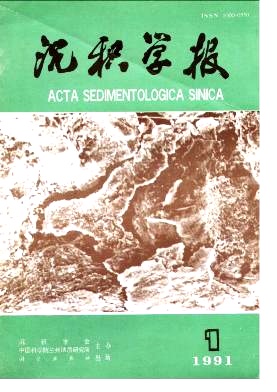Thermodynamic Analysis of the Mineral Assemblages of Shell Fossils
- Received Date: 1988-12-02
- Publish Date: 1991-03-10
Abstract: Based on the mineral compositions of shell fossils formed in prior to Cambrian period, it has been found that all the known biogenic minerals were calcium-minerals, and two third of them are composed of calcium phosphate. With the evolution of biota, the composition of marine skeletons had changed greatly during the Phanerozoic. In the Palaeozoic it was dominated calcite-secreting inverbrate; the Cenozoic and modern seas were characterised by organisms which secreted aragonite and Mg-calcite skeletons, and the Mesozoic seas contained roughly equal numbers of each.This paper, therefore, aims to discuss these problems thermodynamically. 1.Thermodynamic analysis of the forming sequence of carbonate and phosphate minerals. Under the condition of modern seawater, i.e. assumed pH = 8, the total concentration of carbon (∑ [C]) is 1.2×10-3M, and that of phosphorus (∑ [P]) is 2×10-6M.The calculation indicates that αco32- is 8.44×10-3M, and αpo43- is 3.5 × 10-9M.According to the mass-action rule and the Ernst' s equation △Gro = -RT · lnk, the calculated results of αca2+which make the CaCO3and Ca3 (PO4) 2precipitated are: For carbonates αCa2+= 10-3.28M (calcite); αCa2+= 10+3.06M (aragonite) For phosphate αCa2+= 10-3.93M. It shows that the precipitation of phosphate took place first followed by the calcite, and the last was the aragonite. 2. Activity-pH diagram of carbonate and phosphate minerals Based on the fact that there are two types of mineral associations-carbonate (calcite and aragonite) and phosphate minerals in shell fossils, the elements, i. e. carbon, phosphorus, and calcium, are taken into account.They are not related to the Eh condition of environment, because they are not variable-valence elements. As H2CO3 and H3PO4 are polyhydric acids, the incomplete multistage ionization will take place and the αco32- and αpo43- will be controlled by the pH of solutions.Thus, the lowest activity of Ca2+under which CaCO3and Ca3 (PO4) 2 precipitations take place can be calculated by means of the αco32- and αpo43-present in solution at various pH.The logαca2+-pH diagram (Fig.l) can be constructed by using these results. 3.Palaeoenvironment analysis of formation of shell fossils Also it can be seen clearly from Fig. 1, that the precipitation of phosphate minerals take place at pH>2.2, but it does not mean that the phosphate shell can be formed at the early stage of palaeo- ocean evolution under which the pH values were very low in palaeo-seawater.It can be considered that the formation of shells not only depends on the increase of pH values, but also the increase of Ca2+concentrations in seawater.It has been revealed from some gelolgical history information that before the Proterozoic the phosphate deposition took place in local areas on small scale. In Sinian period ( by that time the palaeo-ocean had been formed 2000-2500m · a) the whole earth deposition of phosphates began on large scale followed by the formation of phosphate shells.It was not before long that the carbonate shells formed widely, it indicated that the pH values of seawater were close to 6 at the end of Proterozoic period. With the increase of pH values reached to 6.45 in Cambrian period, carbonate shells, particularly calcite shells with lower solubility, were widely devoloped. From Meso/oic period the formation of aragonite and calcite shells was the result of pH values' increase of the seawater. From Cenozoic to present the pH values of seawater increased gradually up to about 8.1. During this period the aragonite shells were dominant too.
| Citation: | Wu Mingqing, Song Yunhua, Ouyang Ziyuan. Thermodynamic Analysis of the Mineral Assemblages of Shell Fossils[J]. Acta Sedimentologica Sinica, 1991, 9(1): 129-135. |






 DownLoad:
DownLoad: